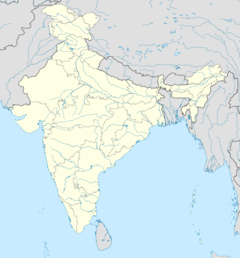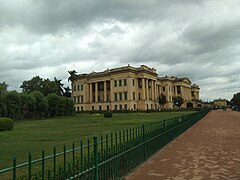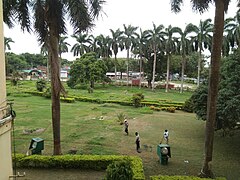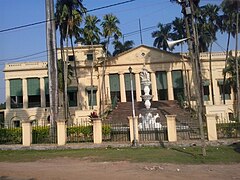
Murshidabad is a historical city in the Indian state of West Bengal. It is located on the eastern bank of the Bhagirathi River, a distributary of the Ganges. It forms part of the Murshidabad district.

The Nawab of Bengal was the hereditary ruler of Bengal Subah in Mughal India. In the early 18th-century, the Nawab of Bengal was the de facto independent ruler of the three regions of Bengal, Bihar and Orissa which constitute the modern-day sovereign country of Bangladesh and the Indian states of West Bengal, Bihar and Odisha. The Bengal Subah reached its peak during the reign of Nawab Shuja-ud-Din Muhammad Khan. They are often referred to as the Nawab of Bengal, Bihar and Orissa. The Nawabs were based in Murshidabad which was centrally located within Bengal, Bihar, and Odisha. Their chief, a former prime minister, became the first Nawab. The Nawabs continued to issue coins in the name of the Mughal Emperor, but for all practical purposes, the Nawabs governed as independent monarchs. Bengal continued to contribute the largest share of funds to the imperial treasury in Delhi. The Nawabs, backed by bankers such as the Jagat Seth, became the financial backbone of the Mughal court.

The Nawab Bahadur of Murshidabad, or simply known as the Nawab of Murshidabad, was a hereditary title of Bengal akin to Western peerage. They were direct descendants of the former Nawabs of Bengal, who were the de facto rulers of Bengal, and inherited their estates and property. The inaugural holder was Hassan Ali Mirza. After the death of Waris Ali Mirza in 1969, the title was held in abeyance and later abolished. In August 2014, the Indian Supreme Court ruled that his nephew, Abbas Ali Meerza, was a rightful heir of the Nawabs of Murshidabad.
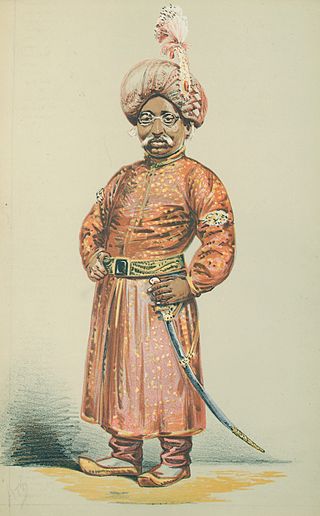
Nawab Sayyid Mansur Ali Khan was the Nawab of Bengal from 1838 until his abdication in 1880, whereupon he renounced his titles and position as Nawab. During his reign, he instituted various policies in the princely state he governed, frequently coming into conflict with the colonial government over monetary issues. Khan was a frequent visitor to Britain, and it was there that he often pleaded his case in regards to disputes with the colonial government. In 1880, Khan decided to abdicate in favour of his eldest son. He died four years later.

The Katra Masjid is a former caravanserai, mosque and the tomb of Nawab Murshid Quli Khan. It was built between 1723 and 1724. It is one of the largest caravanserais in the Indian subcontinent. It was built during the 18th century, when the early modern Bengal Subah was a major hub of trade in Eurasia. The Katra Masjid is located in the north eastern side of the city of Murshidabad, in the Indian state of West Bengal. The most striking feature of the structure are the two large corner towers having loopholes for musketry.

Kathgola Palace is a historical building belonging to the Dugar family at Kathgola in the Murshidabad-Jiaganj CD block of Murshidabad district. It now houses a museum.
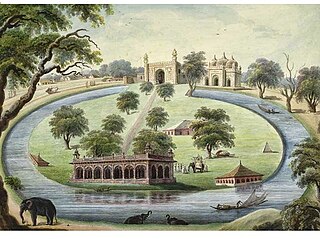
Motijhil, also known as Company's Lake due to its association with the East India Company, is a horse-shoe shaped lake in Murshidabad, West Bengal, India. It was created by Nawazish Muhammad Khan, the son-in-law of Nawab Alivardi Khan. He also constructed a precious palatial palace beside this lake which is called the Sang-i-Dalan which is also known as the Motijhil Palace. It is located at the bend of this lake. It was used as the residence of Nawazish and Ghaseti Begum, Nawazish's beloved wife. It is said that after Nawazish died, Ghaseti Begum lived here until Nawab Siraj ud-Daulah took over the palace and seized the residents' in 1756 AD. With this money he built a similar lake with a beautiful palace, Hirajheel, on the opposite side of the Hooghly River. The palace has a lofty gateway, a mosque known as the "Shahamat Jang" and the Kala Masjid and some other buildings which were all built by Nawazish. This palace was built in 1740. As far as etymology is concerned, the palace has been named so as it was built using black basalt pillars which were brought from the ruins of Gaur. Thus, it was given the name of Sang-i-Dalan or the Stone Palace. This palace was then decorated with different varieties of flower plants and precious marbles.

The Chawk Mosque is a mosque in the city of Murshidabad, India. It was founded in 1767 AD by Munny Begum, wife of Nawab Mir Zafar. Earlier in this place Nawab Murshid Quli Khan had built the "Chahel Sutan", which was the city's forty pillared audience hall. The mosque still recalls the stories of the ruling days of the Nawabs and still holds on its glory of the past.

Fauti Mosque is a mosque at Kumarpur in the Murshidabad-Jiaganj CD block in the Lalbag subdivision of Murshidabad district in West Bengal, India. It was built by Nawab Sarfaraz Khan in 1740 AD. The old Fauti Masjid is one of the largest mosques in the town of Kumarpur and Murshidabad district.

The Nizamat Imambara is a Shia Muslim congregation hall (imambara) in Murshidabad, India. It was built in 1740 AD by Nawab Siraj ud-Daulah and rebuilt in 1847 by Nawab Mansur Ali Khan after it was destroyed by the fires of 1842 and 1846. It is frequently mentioned as the largest imambara in the world.

Wasif Manzil was built by Nawab Wasif Ali Mirza Khan under the direction and supervision of Mr. Vivian, officer of the Public Works Department of the Nadia Rivers Division and Surendra Barat, a Bengali engineer. This building, rather palace was used by the Nawab as his residence. The building is extremely close to the Hazarduari Palace. It is built on the Nizamat Fort Campus between the campus's Dakshin Darwaza and the Hazarduari Palace, just opposite the campus's South Zurud Mosque and parallel to the Bhāgirathi-Hooghly River.

The Madina Mosque is a mosque in the Nizamat Fort Campus in Murshidabad, West Bengal, India. There are two Madina mosques in the fort campus, the old one built by Nawab Siraj ud-Daulah during the 18th century.and the new one by Nawab Mansur Ali Khan in 1847.

The Clock Tower of Murshidabad is a clock tower in the Nizamat Fort Campus in West Bengal, India. The clock tower stands in the garden space between the Nizamat Imambara and the Hazarduari Palace; to its east, hardly a few feet away, is the old Madina Mosque and the Bacchawali Tope.
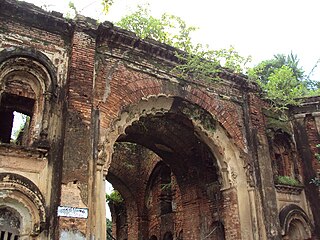
Namak Haram Deorhi was the palace of Mir Jafar. It is located just opposite to the Jafarganj Cemetery in the Lalbagh area of the town of Murshidabad and near Mahimapur in the Indian state of West Bengal. Namak Haram Deorhi refers to both the place of Mir Jafar and the main gate which leads to the palace. This building was used as the residence of Mir Jafar, before he ascended the musnad of Bengal or when he was the Commander-in-Chief of the subha.
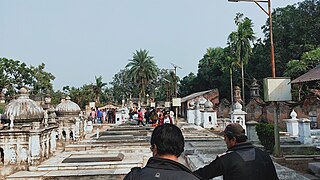
Jafarganj Cemetery is located in Murshidabad, West Bengal, India.

West Bengal is a state in the eastern region of India and is the nation's fourth-most populous state. The state capital is Kolkata. The state encompasses two broad natural regions: the Gangetic Plain in the south and the sub-Himalayan and Himalayan area in the north. The tourism in West Bengal is maintained by WBTDCL, a state government owned enterprise.
Tomb of Azimunissa Begum is located at Azimnagar, in the Murshidabad district.

Yellow Mosque is situated in the Hazarduari Palace complex at Murshidabad, West Bengal, India.
Kherur Mosque is located at Kherur in the Sagardighi CD block in the Jangipur subdivision of Murshidabad district, West Bengal, India.

Jama Masjid is a congregational mosque located at Motijhil, in the historic city of Murshidabad, West Bengal, India.


